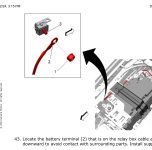Thomas_L
New member
I had a DC-to-DC charger ("Ecoflow alternator charger") installed, and the shop connected the positive terminal to the fuse box instead of directly to the positive terminal (see attached picture). It works, but I'm wondering if this is equally safe, especially given the amount of trouble that poorly done electrical work causes? I'm wondering if the high wattage is a concern (800W), and that it locates the actual fuse of that cable (which you can see on the very right of the picture in green) further away from the connection to the battery.
Also, the insulation of the cable got damaged when they put the cover back on the fuse box (you can see the gap in the black part, and further to the left the damage on the red part), so the wire is exposed. I guess I should replace that part of the cable (and at that occasion connect it to the positive terminal directly)? I hope it's safe to use the vehicle with the charger off?

Also, the insulation of the cable got damaged when they put the cover back on the fuse box (you can see the gap in the black part, and further to the left the damage on the red part), so the wire is exposed. I guess I should replace that part of the cable (and at that occasion connect it to the positive terminal directly)? I hope it's safe to use the vehicle with the charger off?









